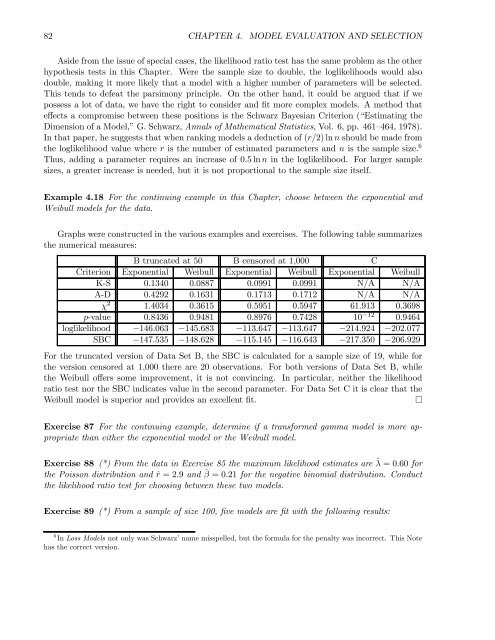Estimation, Evaluation, and Selection of Actuarial Models
Estimation, Evaluation, and Selection of Actuarial Models
Estimation, Evaluation, and Selection of Actuarial Models
You also want an ePaper? Increase the reach of your titles
YUMPU automatically turns print PDFs into web optimized ePapers that Google loves.
82 CHAPTER 4. MODEL EVALUATION AND SELECTION<br />
Aside from the issue <strong>of</strong> special cases, the likelihood ratio test has the same problem as the other<br />
hypothesis tests in this Chapter. Were the sample size to double, the loglikelihoods would also<br />
double, making it more likely that a model with a higher number <strong>of</strong> parameters will be selected.<br />
This tends to defeat the parsimony principle. On the other h<strong>and</strong>, it could be argued that if we<br />
possess a lot <strong>of</strong> data, we have the right to consider <strong>and</strong> fit more complex models. A method that<br />
effects a compromise between these positions is the Schwarz Bayesian Criterion (“Estimating the<br />
Dimension <strong>of</strong> a Model,” G. Schwarz, Annals <strong>of</strong> Mathematical Statistics, Vol. 6, pp. 461—464, 1978).<br />
In that paper, he suggests that when ranking models a deduction <strong>of</strong> (r/2) ln n should be made from<br />
the loglikelihood value where r is the number <strong>of</strong> estimated parameters <strong>and</strong> n is the sample size. 6<br />
Thus, adding a parameter requires an increase <strong>of</strong> 0.5lnn in the loglikelihood. For larger sample<br />
sizes, a greater increase is needed, but it is not proportional to the sample size itself.<br />
Example 4.18 For the continuing example in this Chapter, choose between the exponential <strong>and</strong><br />
Weibull models for the data.<br />
Graphs were constructed in the various examples <strong>and</strong> exercises. The following table summarizes<br />
the numerical measures:<br />
B truncated at 50 B censored at 1,000 C<br />
Criterion Exponential Weibull Exponential Weibull Exponential Weibull<br />
K-S 0.1340 0.0887 0.0991 0.0991 N/A N/A<br />
A-D 0.4292 0.1631 0.1713 0.1712 N/A N/A<br />
χ 2 1.4034 0.3615 0.5951 0.5947 61.913 0.3698<br />
p-value 0.8436 0.9481 0.8976 0.7428 10 −12 0.9464<br />
loglikelihood −146.063 −145.683 −113.647 −113.647 −214.924 −202.077<br />
SBC −147.535 −148.628 −115.145 −116.643 −217.350 −206.929<br />
For the truncated version <strong>of</strong> Data Set B, the SBC is calculated for a sample size <strong>of</strong> 19, while for<br />
the version censored at 1,000 there are 20 observations. For both versions <strong>of</strong> Data Set B, while<br />
the Weibull <strong>of</strong>fers some improvement, it is not convincing. In particular, neither the likelihood<br />
ratio test nor the SBC indicates value in the second parameter. For Data Set C it is clear that the<br />
Weibull model is superior <strong>and</strong> provides an excellent fit. ¤<br />
Exercise 87 For the continuing example, determine if a transformed gamma model is more appropriate<br />
than either the exponential model or the Weibull model.<br />
Exercise 88 (*) From the data in Exercise 85 the maximum likelihood estimates are ˆλ =0.60 for<br />
the Poisson distribution <strong>and</strong> ˆr =2.9 <strong>and</strong> ˆβ =0.21 for the negative binomial distribution. Conduct<br />
the likelihood ratio test for choosing between these two models.<br />
Exercise 89 (*) From a sample <strong>of</strong> size 100, five models are fit with the following results:<br />
6 In Loss <strong>Models</strong> not only was Schwarz’ name misspelled, but the formula for the penalty was incorrect. This Note<br />
has the correct version.
















